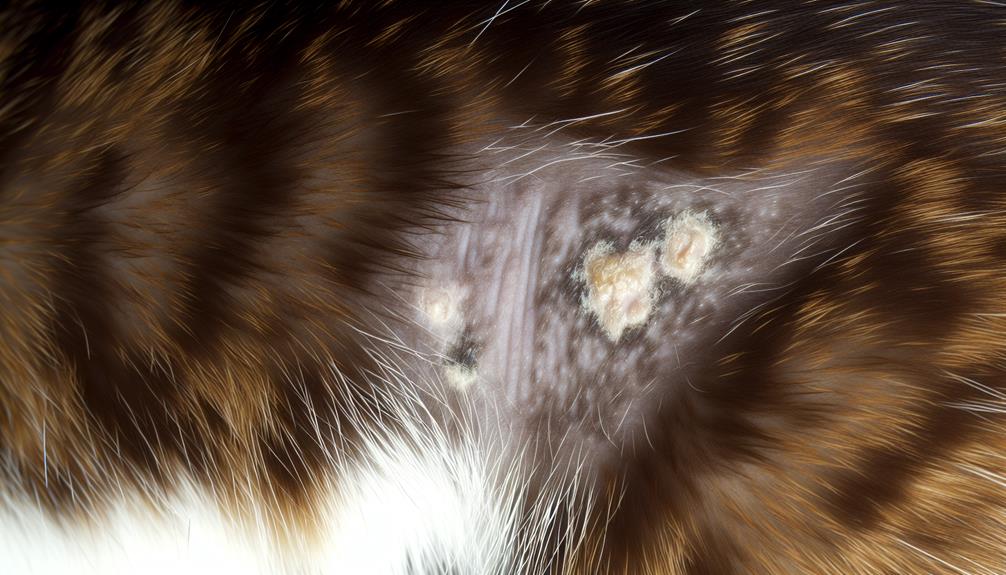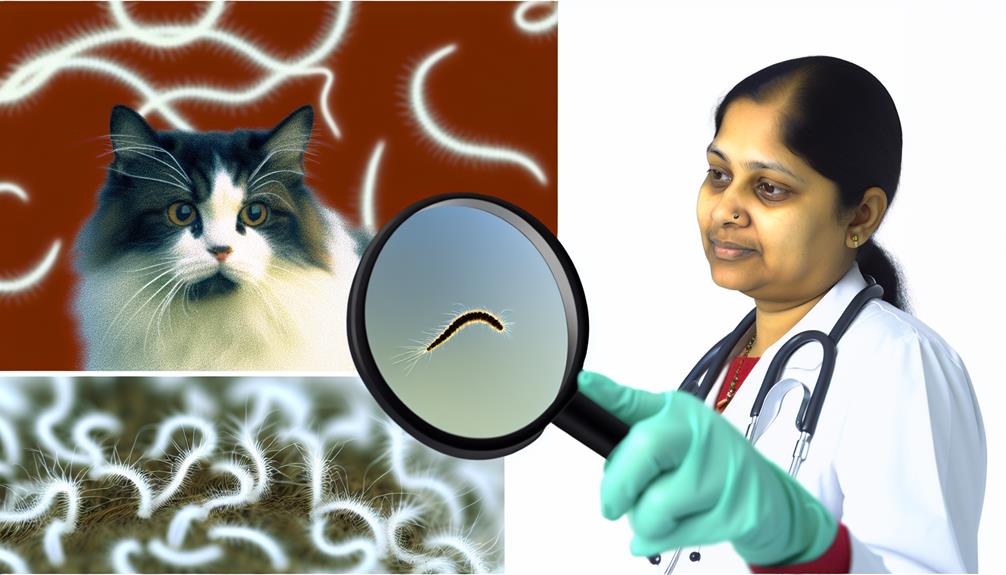Wondering if your cat might have worms can be concerning, but there are clear signs to watch for that can help you determine if a vet visit is necessary. Has your cat been losing weight despite eating normally, or does its abdomen appear bloated? You might also notice changes in behavior, such as lethargy or irritability. Occasionally, you'll spot rice-like segments in their feces, which are indicative of tapeworms. These are just a few potential indicators, but knowing what to look for is essential to your pet's health. Curious about the next steps to take for a proper diagnosis?
Common Symptoms
When it comes to identifying whether your cat has worms, recognizing common symptoms is vital. Cats with worm infestations often exhibit behavior changes that can be subtle or pronounced. You might notice your cat becoming lethargic, more irritable, or less interested in activities they usually enjoy. These behavior changes can be attributed to the discomfort and internal stress caused by the parasitic infection.
Another significant indicator is appetite fluctuations. Cats with worms may experience periods of increased hunger, as the parasites compete for nutrients within their digestive system. Conversely, some cats may lose their appetite entirely due to gastrointestinal upset or discomfort. Monitoring your cat's eating habits closely can provide important clues about their health status.
In addition to behavior changes and appetite fluctuations, pay attention to your cat's physical appearance. A bloated or distended abdomen can be a sign of a heavy worm burden. You might also observe weight loss despite a normal or increased appetite, as the parasites siphon off essential nutrients. Moreover, a dull coat, accompanied by excessive shedding or poor grooming habits, can indicate a compromised immune system.
It's also essential to inspect your cat's feces and vomit for visible signs of worms. Tiny, rice-like segments in the feces or around the anal area often indicate a tapeworm infection. Roundworms, on the other hand, may appear as spaghetti-like strands in vomit or feces.
Types of Cat Worms
Understanding the types of worms that can infect your cat is essential for effective diagnosis and treatment. Common intestinal parasites include roundworms and hookworms, whereas tapeworms often result from ingesting infected fleas. Additionally, heartworms, though less common, can pose severe health risks to felines.
Roundworms and Hookworms
Roundworms and hookworms represent two common parasitic infections that can afflict your feline companion. Understanding the worm lifecycle is vital to safeguarding your cat's health. Roundworms (Toxocara cati) are often transmitted through ingestion of infected feces or prey. They mature in the intestines, causing symptoms like vomiting, diarrhea, and a pot-bellied appearance in kittens.
Hookworms (Ancylostoma spp.), on the other hand, are smaller but more insidious. These parasites attach to the intestinal wall, feeding on blood and leading to anemia, weight loss, and lethargy. Both types of worms can markedly compromise feline health if left untreated.
| Parasite | Transmission |
|---|---|
| Roundworms | Ingesting infected material |
| Hookworms | Skin penetration, ingestion |
| Symptoms | Diagnosis |
| Vomiting | Fecal examination |
| Anemia | Blood tests |
Identifying these infections early is essential. Regular fecal examinations and blood tests can detect the presence of these parasites. Treatment typically involves anthelmintic medications, which are effective in eradicating both roundworms and hookworms. Preventive measures, such as maintaining a clean living environment and regular veterinary check-ups, are also critical in ensuring your cat remains worm-free.
Tapeworms in Cats
Moving from roundworms and hookworms, another common parasitic infection in cats involves tapeworms. Tapeworms are segmented parasites that attach to the intestinal lining of your cat using their hook-like mouthparts. The tapeworm life cycle typically involves an intermediate host, often a flea, which a cat ingests during grooming. Once inside the cat, the tapeworm larva matures into an adult, capable of producing segments filled with eggs. These segments are then excreted in the cat's feces, perpetuating the cycle.
Clinical signs of tapeworm infestation include the presence of small, rice-like segments around the cat's anus or in their bedding. Your cat may also exhibit increased hunger, weight loss, or scooting behavior due to anal irritation.
Treatment methods for tapeworms are effective and generally involve oral or topical anthelmintic medications such as praziquantel or epsiprantel. These compounds work by disrupting the parasite's cellular metabolism, leading to its eventual disintegration and expulsion from the host. Preventive measures should also be taken, such as regular flea control, to break the tapeworm life cycle and reduce the risk of re-infestation. Consult your veterinarian for the most appropriate treatment regimen for your pet.
Heartworms in Felines
Heartworms in felines present a serious and often underdiagnosed health threat. Unlike canines, cats are atypical hosts for heartworms, making the diagnosis challenging. The heartworm lifecycle in cats begins when a mosquito carrying infective larvae bites your feline. These larvae migrate through the tissues, eventually reaching the pulmonary arteries. In cats, the presence of even a few worms can lead to severe respiratory issues, a condition known as Heartworm Associated Respiratory Disease (HARD).
You might think your indoor cat is safe, but indoor prevention is essential. Mosquitoes can easily enter homes, putting indoor cats at risk. Symptoms are often subtle or resemble other respiratory diseases, including coughing, wheezing, and vomiting. In severe cases, sudden collapse or even death can occur.
Preventative measures should be discussed with your veterinarian. Heartworm preventatives are available and should be administered monthly. Testing and early intervention are key, as there's no approved treatment for feline heartworm infections. Regular veterinary check-ups, alongside vigilant indoor prevention strategies, can protect your cat from this insidious parasite. Understanding the heartworm lifecycle and implementing preventative care can save your feline from potentially life-threatening complications.
Diagnosing Worms

To diagnose worms in your cat, start by observing visible symptoms such as weight loss, diarrhea, and a distended abdomen. It's essential to schedule a veterinary examination for a definitive diagnosis, as a vet can identify common types like roundworms and tapeworms through fecal tests and other diagnostic tools. Prompt and accurate identification guarantees targeted and effective treatment.
Visible Symptoms Check
When it comes to diagnosing worms in your cat, a thorough visible symptoms check is essential. Observing your cat's physical condition and behavior can provide valuable clues to the presence of parasitic infections. Key indicators like dietary changes and behavioral shifts are often tell-tale signs.
| Symptom | Description | Importance |
|---|---|---|
| Weight Loss | Unexplained weight reduction | Indicates nutrient absorption issues |
| Increased Appetite | Eating more but not gaining weight | Suggests nutrient competition with worms |
| Vomiting | Frequent, sometimes with worms present | Direct sign of worm infestation |
| Diarrhea | Loose stools, sometimes with blood | Points to intestinal irritation |
Pay attention to your cat's weight. Sudden, unexplained weight loss despite a normal or increased appetite can indicate that worms are robbing your cat of essential nutrients. Vomiting, especially if you notice worms present, is a direct sign of infestation. Diarrhea, sometimes accompanied by blood, often suggests intestinal irritation due to worms.
Behavioral shifts, such as increased irritability or lethargy, can also be significant. If your cat's grooming habits change, or if you spot segments of worms around the anal area or in their feces, it's a red flag indicating a potential parasitic problem. Regularly monitoring these symptoms can help you catch an infestation early and seek timely treatment.
Veterinary Examination Importance
Although observing visible symptoms is vital, nothing replaces the precision of a veterinary examination when diagnosing worms in your cat. Veterinary expertise is essential in accurately identifying parasitic infections, as many symptoms can be nonspecific and overlap with other health issues. A thorough health assessment performed by a veterinarian includes a detailed history, physical examination, and specific diagnostic tests such as fecal analysis and blood tests.
A fecal flotation test is a cornerstone in the diagnosis of intestinal parasites, allowing the veterinarian to identify worm eggs under a microscope. Additionally, blood tests can detect certain types of worms, such as heartworms, which may not be evident through fecal examination alone. This multifaceted approach guarantees a reliable diagnosis, as parasitic infections can greatly impact your cat's health if left untreated.
Moreover, veterinarians possess the clinical knowledge to differentiate between various types of worms, each requiring distinct treatment protocols. This expertise is vital for effective parasite management and prevention. As a result, entrusting your cat's health to a professional not only confirms the presence of worms but also facilitates a tailored treatment plan, safeguarding your feline friend's well-being.
Common Types Identified
Several common types of worms can infect cats, each presenting unique diagnostic challenges and requiring specific treatments. The most prevalent are roundworms, tapeworms, hookworms, and lungworms. Roundworms, such as Toxocara cati, often cause abdominal swelling and can be identified through fecal examinations. Tapeworms, including Dipylidium caninum, manifest as segments visible around the cat's anus or in its feces, often linked to flea infestations.
Hookworms, like Ancylostoma tubaeforme, can cause severe anemia, especially in kittens. They are typically diagnosed via microscopic examination of fecal matter. Lungworms, such as Aelurostrongylus abstrusus, affect the respiratory system, leading to coughing and respiratory distress. Diagnosis usually involves specialized tests, including bronchoscopy or fecal flotation techniques.
Dietary changes and environmental factors greatly influence the likelihood of worm infestations. For instance, cats that hunt or consume raw meat are at higher risk for various parasites. Likewise, living conditions, such as exposure to contaminated soil or other infected animals, can increase susceptibility. Regular deworming protocols and maintaining a clean living environment are vital preventive measures. Always consult your veterinarian for the most accurate diagnosis and tailored treatment plan for your feline companion.
Transmission Methods
Understanding the various transmission methods of worms in cats is essential for effective prevention and treatment. Worms can be transmitted through multiple routes, each with its own set of environmental factors. By knowing these transmission routes, you can better safeguard your feline companion against these parasitic infections.
One primary transmission route is through ingestion of worm eggs or larvae found in contaminated soil or feces. Outdoor cats are particularly susceptible, as they frequently come into contact with these environmental factors. Another significant transmission route involves the ingestion of intermediate hosts, such as rodents, birds, or even insects, that carry the infective stages of the worms. This is common for tapeworms, where cats ingest fleas harboring tapeworm larvae during grooming.
Vertical transmission is another route, where kittens can acquire worms from their mother either through the placenta before birth or via colostrum and milk during nursing. This occurs particularly with roundworms and hookworms. Additionally, some worms can penetrate a cat's skin directly, particularly hookworms, which are prevalent in environments with moist, warm soil.
Environmental factors such as poor sanitation, overcrowded living conditions, and insufficient deworming practices can exacerbate the risk of worm transmission. For instance, communal litter boxes or outdoor spaces shared by multiple cats can increase the prevalence of worm eggs in the environment, thereby elevating the risk of infection.
Treatment Options

When it comes to treating worms in cats, a multifaceted approach is often required to guarantee complete eradication and prevent recurrence. Pharmacological interventions should be the cornerstone of treatment, with options such as broad-spectrum anthelmintics, including praziquantel, fenbendazole, and milbemycin oxime. These medications are effective against a range of parasites, including roundworms, tapeworms, and hookworms. Always consult a veterinarian to determine the most appropriate drug and dosage for your cat.
In addition to pharmaceuticals, incorporating natural remedies can support the overall treatment regimen. For instance, pumpkin seeds contain cucurbitacin, a compound known for its anthelmintic properties. Adding finely ground pumpkin seeds to your cat's diet may help expel intestinal worms. Another option is the use of food-grade diatomaceous earth, which can create an inhospitable environment for parasites without harming your cat.
Dietary adjustments are also vital for enhancing your cat's immune system, making it less susceptible to reinfestation. High-quality, protein-rich diets can fortify your cat's natural defenses. Additionally, incorporating probiotics can promote a healthy gut microbiome, which may further deter parasitic colonization.
Prevention Tips
Preventive measures are essential in guaranteeing your cat remains worm-free and maintains ideal health. Implementing a multifaceted approach involving dietary considerations and strict hygiene practices can greatly reduce the risk of parasitic infections. Here are some evidence-based tips to prevent worms in your feline companion:
- Regular Veterinary Check-Ups: Scheduling routine veterinary visits guarantees early detection and timely management of any parasitic infections. Veterinarians can recommend appropriate deworming schedules tailored to your cat's needs.
- Hygiene Practices: Maintaining a clean environment is critical. Regularly clean your cat's litter box, bedding, and feeding areas to minimize the risk of worm eggs and larvae. Washing your hands after handling your cat or cleaning their items also reduces the transmission risk.
- Dietary Considerations: Providing a balanced diet strengthens your cat's immune system, making it less susceptible to infections. Avoid feeding raw or undercooked meat, as these can be sources of parasitic larvae.
- Control of Intermediate Hosts: Fleas, ticks, and rodents can act as intermediate hosts for various worms. Effective flea and tick control measures, including the use of anti-parasitic medications, are essential in breaking the transmission cycle.
Conclusion
To summarize, ensuring your cat remains worm-free involves vigilance and regular veterinary care. It's easy to dismiss subtle symptoms, but overlooking them could lead to serious health issues. Picture your once playful feline, now lethargic and irritable, suffering silently. Don't let that be your cat's fate. Regular check-ups, fecal tests, and preventive measures will keep your pet healthy and happy. Trust the evidence: proactive care is the key to a worm-free, vibrant life for your cat.
